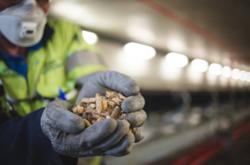Ah, Canada.
One-hundred-and-forty-eight years into this post-colonial experiment, today's self-congratulatory celebrations of our past might incline us to consider, as well, our future as a nation. It's an especially ripe question this summer, when no barbecue or beach party or parade is safe from the cloying attentions of the hundreds of candidates vying for low office come October.
So, cast your minds ahead. Not too far, but how about 15 years? O Canada, 15 years from now, what will we have wrought? To what do we aspire as a country?
Well, for one-and-a-half times B.C.'s minimum hourly wage, you can go to the cinema today and see a somewhat apocalyptic 3D vision of the future from the myth makers in Hollywood, in the guise of Mad Max: Fury Road. As Anthony Lane helpfully summarizes in The New Yorker, "There are no cities or civilizations left. The landscape is dying of thirst; water -- known as Aqua Cola -- is severely rationed; and other resources, notably gasoline, are hoarded and tussled over like scraps of food." The movie is a rollicking and riotous ride through a future in which, as Lane says, "the world is all churned up."
Or all burned up. Look north to Alaska's and British Columbia's wildfires, and south to Washington's fires and California's drought, and east to the indelible stain of the tarsands, and you could be forgiven for thinking we are already on the on-ramp to Fury Road.
But not so fast, you say, things aren't so bad. We have cities and civilizations and oil in abundance, and since we almost all agree we have to stop using the stuff, the G7 group of nations has declared that we can de-carbonize the global economy by 2100. That goal, albeit an "aspirational" one in the view of Prime Minister Stephen Harper, to my mind seems like a bet with a very big hedge around it. Call me simple, but a deadline that's 85 years off doesn't exactly instil a sense of urgency -- especially when it's set by people inhabiting the ass-end of the actuarial table. Easy for them to set a deadline that even their grandchildren probably won't live to see.
So let's back up seven decades and think about what things might look like 15 years from now. Why 15? Well, a lot of baby boomers are still going to be kicking around, and by then a lot of millennials will be running things. So a lot of us have a very serious and urgent stake in what happens next, even though famed oceanographer Dr. Sylvia Earle thinks even 15 years is too far out. "What we do in the next 10 years matters more than that what humanity does in the next 10,000," Earle says.
I certainly share Dr. Earle's sense that the world is on the brink of calamitously irreversible changes to our climate, and fear that maybe even 10 years is too short a time frame. But 15 years is a useful measure for a couple of reasons. At the beginning of last week Unicef forecast absolutely dire conditions that will confront the world's poorest children between now and 2030. Its assessment was a "final report card" on whether children had been helped or harmed by the Millennium Development Goals established back in 2000 for measuring progress in reducing poverty, hunger, child mortality, gender inequality, illiteracy and environmental degradation by the end of 2015 -- i.e. this year.
The MDGs apparently did some good, although because targets were established using national averages, some countries focused on the wrong kids. "In the rush to make that (nationally averaged) progress, many focused on the easiest-to-reach children and communities, not those in greatest need," said Anthony Lake, Unicef's executive director. So kids in the toughest shape weren't always the ones who got help.
"If current trends continue, we will fail children," Lake said.
Climate change as global epidemic
The MDGs are soon to be replaced with SDGs, or Sustainable Development Goals, at the United Nations General Assembly planned for September. Those goals, clearly "aspirational" if recent history is any guide, stretch over the next 15 years during which time "current trends," after accounting for population growth, will have us witness the deaths of 68 million children under the age of five from mostly preventable causes. That's 4.5 million kids a year. A further 119 million will suffer stunted development.
And here is a charming estimate: by 2030, Unicef predicts, a half a billion people on our planet will practice "open defecation" as a matter of course. This isn't just a poop in the woods on a camping trip: this is 500 million people soiling where they live (and prematurely die), where they draw water (if there is any) and gather food (if there is any), every day. Perhaps this is what Pope Francis had in mind when, in his recent climate change encyclical, Laudato Si', he referred to an Earth that begins "to look more and more like an immense pile of filth." It's not just kids who will suffer, either.
On the same day Unicef's report came out, the British medical journal The Lancet released an online report saying more people will be exposed to floods, drought, heat waves and other extreme weather over the next century than previously thought. Exposure to extreme rainfall will quadruple and exposure to drought will triple compared to the 1990s. Exposure of older people to heat waves is estimated to rise by a factor of 12.
The Lancet first convened scientists to study climate change's effects on people in 2009, then declaring that it was "the biggest global health threat of the 21st century." Since global carbon emission rates have already risen above the worst-case scenarios used back in 2009, "everything that was predicted in 2009 is already happening," according to Nick Watts, a public health expert at the Institute for Global Health at University College London. A report on this appeared in the June 22 New York Times alongside another report, from Karachi, accompanied by a picture of 45 shrouded and trussed unclaimed bodies that were being buried to make way for more victims of a heat wave in Pakistan. Turn the page of the New York Times that day, and lo, a warning from the US Environmental Protection Agency that the U.S. faces up to $180 billion in losses by the end of the century because of drought and water shortages that will occur in the absence of global action to curb greenhouse gas emissions.
Infrastructure of madness
Where does it end? Well, it doesn't, or leastways not by 2030, if the G20 has got anything to do with it. I somehow missed the announcement late last year by the world's richest countries that in the next 15 years, they plan to spend $70 trillion on new infrastructure developments -- mostly on roads, ports, power and communications. This is a doubling of world infrastructure in 15 years. That's right, think about all the infrastructure that exists in the world right now and double it. In Canada, we'll try to do our bit of course -- Site C (or not), LNG (or not), pipelines (or not), more tarsands mines (undoubtedly), Energy East (or not), and to be fair, more transit (or not), but absolutely more bike lanes.
The delusion perpetuated by our governments is that all this infrastructure will help float all our boats higher, although in reality the only thing that will guarantee that is rising sea levels.
"Everywhere one looks, new infrastructure is proliferating in the world's last wild places, often provoking serious environmental harm," writes William F. Laurance, an internationally respected Australian conservationist. A "contemporary avalanche of mining and fossil fuel projects" is about to beset the planet, Laurance says. "Africa is currently experiencing a feeding frenzy of foreign mining investment, with China alone pouring over $100 billion annually into mining projects there. Investors from India, Brazil, Canada and Australia are not far behind." The recent infrastructure pledge by the G20 "simply reflects a new emerging world order," Laurance says. Or maybe it's an old one, the same world order that has ensured that the poor -- and in Canada's case, that's mostly our First Nations communities upon whose lands most industrial infrastructure gets built -- gain the least.
Investment death spiral
And yet we seem unable to stop adding insult to injury. Even with oil prices plummeting, industry is locked into a kind of investment death spiral. Yes, investments in the tarsands have been curtailed by the fall in oil prices, but there is still plenty of capital bound for Wood Buffalo. Like a troop surge in Iraq, our reaction to market trauma is just to invite more of it, "pumping record volumes of crude despite sinking profits and warnings of an extended stretch of weak prices," to quote Canada's national oil journal, the Globe and Mail.
And we continue, stupidly, to look for more oil.
"Considering that western companies spend about $450 billion annually on (worldwide) exploration and development, this could be one of the worst misallocations of capital in history," wrote Anatole Kaletsky in the International New York Times Econoclast column in December. "With the global atmosphere approaching its carbon limits and technological progress gradually reducing the price of non-fossil fuels, the Bank of England warn(s) that some of the world's oil reserves could be left with no market value despite the huge sums sunk into the ground by oil companies, their shareholders and banks.
"The Saudis are well aware of this risk. Back in the 1970s, Sheik Ahmed Zaki Yamani, the Saudi oil minister, used to warn his copatriots not to rely forever on selling oil: the Stone Age didn't end because the cave men ran out of stones. Maybe the end of the 'Oil Age' is now approaching, and the Saudis have understood this better than western oilmen." Better, certainly, than Canadian ones.
And better, certainly, than our PM, Oil Slick Steve. Despite one estimate, by the International Labour Organization, that green jobs could constitute half the global workforce by 2030 -- that's right, just 15 years from now -- Harper has expressed zero interest in promoting renewable energy in this country. No doubt he thinks it is too "aspirational" to make the shift from fossils to renewables any time soon, if at all. ("Aspirational," a term also coined by the Harper government after it first refused to ratify the UN Declaration on the Rights of Indigenous Peoples in 2007, but finally gave its qualified endorsement in 2010, and has since done nothing to implement it -- truth and reconciliation be damned.)
Act on your aspirations
Well, the Harper government isn't alone in having aspirational goals (although it might have cornered the market in using them as a smoke screen for inaction). As it happens, the Canadian electorate also has aspirations, one of which surely is to turn around our headlong race to climate catastrophe, courtesy of the Harper Conservatives. And another of which might be to recover our place in the world as a country that takes its global responsibilities seriously, and might work with other countries to help avert rather than abet the deaths of 12,500 kids a day, every day, for the next 15 years and then some.
Admittedly, this is a lot to think about on our national day of rest and revelry. So let's back up from 15 years out, and think about what we can do 15 weeks from now, when our federal election campaign will be in full swing. Then, as now, we'll be confronted with a choice that will largely determine whether or not we are headed down Fury Road, which is where Stephen Harper is taking us.
We can, we have to aspire to more than that, and we need to act.
We need to choose a road that begins to restore Canada's land and water, and our standing in the world.
At October's electoral crossroads, that starts with seeing off Stephen Harper and his cronies, whose conniving, corrupt and bankrupt view of the world will be the death of us all -- and a lot of other people besides. ![]()
Read more: Energy, Environment

















Tyee Commenting Guidelines
Comments that violate guidelines risk being deleted, and violations may result in a temporary or permanent user ban. Maintain the spirit of good conversation to stay in the discussion.
*Please note The Tyee is not a forum for spreading misinformation about COVID-19, denying its existence or minimizing its risk to public health.
Do:
Do not: